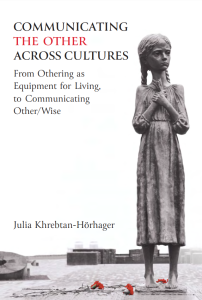Julia Khrebtan-Hörhager. Communicating the Other across Cultures: From Othering as Equipment for Living, to Communicating Other/Wise (Michigan University Press, 2023). 348 pp. ISBN: 9780472076529. US$79.95 (Hardcover).
Evgeniya Pyatovskaya, PhD (USA)

If we take a snapshot of events happening globally in 2023 we will see in it how refugees flock to the Italian island of Lampedusa, despite the police brutality and shortage of food, and embody the European Union’s refugee crisis (Giufridda, 2023), how Black people in the U.S. continue to suffer from race-related violence (Al Jazeera staff, 2023; Andone, 2023), how Armenians in Nagorno-Karabakh region are displaced by Azerbaidjan’s recent offensive (Mpoke Bigg & Nechepurenko, 2023), how Ukrainians are vilified by the Russian government in its ongoing war (Khrebtan-Hörhager, 2023), how Israeli are bombarded by the Palestinian Hamas (Macaron, 2023). In short, we are all too familiar with the idea of the Other – the different, the “not us,” and often “the worse than us.” Their faces change depending on what dominant culture they are aga(IN)st, yet their images are clear to those in power and to lay people – they use them to explain violence, silencing, marginalization, and, ultimately, reason why the powerful ones should stay in power. The examples above are just a few in the pandemic of Othering that has been evolving since the dawn on time, but nowadays the extermination, the displacement, the suffering of the Other(s) is as acute as ever.
In this context, Julia Khrebtan-Hörhager ‘s (Michigan University Press, 2023, 348 pages) groundbreaking Communicating the Other across Cultures: From Othering as Equipment for Living, to Communicating Other/Wise is a timely, complex and nuanced work on the topic of intercultural Othering, through a multitude of perspectives. A distinguished intercultural communication scholar, Dr. Khrebtan-Hörhager tackles the phenomenon of Othering from a critical cultural and comparative perspective. The author begins by masterfully entwining cross-cultural and cross-temporal examples of verbal, visual, and material cultural Othering in the U.S., Russia, and select countries of Western Europe, with intersectional analysis to poignantly demonstrate the universal nature, unchecked embeddedness, and omnipresence of Othering as an urgent and universal phenomenon. Analyzing a great variety of various classic, historic, and contemporary rhetorical texts, famous films, posters, monuments, and museums frequented by locals and tourists in the U.S., Russia, and Europe, Khrebtan-Hörhager paints a compelling picture of how multiple Others are constructed within each dominant culture and how their countless depictions are exploited to benefit Masters’ narratives of superiority. She urges readers to recognize the very real implications of Othering to the lives of those they habitually label as Others. Finally, Khrebtan-Hörhager points to the idea of communicating Other/Wise as a multilayered and sophisticated way the Other engages in rhetoric of resistance. Such rhetoric aims to interrupt Master’s monologue about the Other, to extricate ourselves from its stranglehold, and to subvert Master’s narratives in order to encourage learning from and with the Other, and start living Other/Wise.
Khrebtan-Hörhager broaches an uneasy and complex topic of cultural Othering from an intercultural, intergenerational, and intertemporal perspectives. The book consists of two parts with three chapters in each part. Each chapter in Part I offers historicized analyses of verbal, visual, and material discourses of Othering in three different geopolitical locations. By looking at the U.S., Russia, and some Western European countries like France, Italy, Austria, the UK, and Germany, Khrebtan-Hörhager successfully argues that Othering is utilized by all socio-political systems alike and in a very similar manner–multiple forms of Othering are ingrained into the everyday to a point of their absolute normalization. Khrebtan-Hörhager connects Othering to narratives, values, and realities of domination in these countries, noting its convenient flexibility when serving the interests of those in power: who is Othered changes with political and economic shifts and the needs of the elite, yet the mechanisms of silencing and erasure stay largely the same.
The breadth of the sources analyzed, and their belonging to diverse cultures is the true value of the book. Critically engaging with iconic texts like Mark Twain’s Adventures of Huckleberry Finn, Alexander Pushkin’s Eugene Onegin, or Joseph Conrad’s Heart of Darkness, popular films like King Kong, and well-known places such as the Musée du Quai Branly in Paris or the Ellis Island in New York City, Khrebtan-Hörhager makes a strong case for how intersections of texts, images, and objects (re)create and perpetuate insidious us/them binaries of imperialism, colonialism, racism, patriarchy, and classism, that prescribe how we see, interpret, and treat Others.
In her analysis the author enters a conversation with such scholars as Edward W. Said, bell hooks, Kent Ono, Linda Alcoff, Lisa A. Flores and others, to provide a critical examination of the legacies of Othering and illuminate its processes as tools employed by the dominant powers via various cultural schemata of domination and submission.
The second part of the book focuses on the important approach of unlearning the ideas promoted by sustained Othering once we can recognize and/or decipher them in seemingly benign texts, images, and objects, and doing it through the engagement with the knowledge generated by Others. In this part, Khrebtan-Hörhager draws on texts like N. Scott Momaday’s House Made of Dawn, Guzel Yakhina’s Zuleikha Opens her Eyes, and Bernardine Evaristo’s Girl, Woman, Other, eye-opening art by T.C. Cannon, documentary films by John and Kenny Little (More than a Word), Spike Lee (BlacKkKlansman and Da 5 Bloods) and Mbeka Phoba (Souer Oyo) among other literary and cinematographic masterpieces of the Other(s) to highlight how seeing, writing, and living differently has been practiced throughout history, regardless of the dominant narratives that strived to diminish and silence the Other. Through her attentive analyses Khrebtan-Hörhager illuminates both precarious and generative nature of communicating Other/Wise. Exposure to and mindful engagement with different ways of knowing and communicating, and diverse worldviews, inevitably changes the way we interpret and engage with the dominant ideas that have been previously communicated as unshakeable, monumental cornerstones to the respective nations: liberation might suddenly become occupation, and reunification is in fact an unlawful annexation. The second part of the book clearly demonstrates how dominant narratives have been resisted across cultural contexts and through a rich assemblage of discursive forms.
The book is a major contribution to the field of intercultural studies and studies of cultural Othering. It reveals Othering’s many faces. While similar research of Othering exists, the unique and unparalleled contribution of this book is its intercultural and intertemporal span, and the richness of analyzed material. It thoughtfully leads the reader from its past into the present moment to demonstrate the Othering’s numerous incarnations in their various geopolitical habitats.
By bringing together a multitude of sources and artifacts, it considers Othering extensively and draws comparisons across nations and ways of communicating, this brilliant book allows the reader to face the rootedness and habituality of Othering in our lives, its normalization, and its almost seamless blending into our conceptualizations of self through juxtaposition, often dangerous, to Others. Yet, Khrebtan-Hörhager balances a complex viewing of Othering and its harmful effects with empowering examples of how we can start communicating and living Other/Wise. Overall, Communicating the Other across Cultures: From Othering as Equipment of Living to Communicating Other/Wise offers an intellectually stimulating, rigorously analyzed, and historically extremely well-informed study of the phenomenon of Othering worldwide. It engages a wide variety of disciplines without yet compromising on the original aims and scope of the book. Therefore, Communicating the Other across Cultures provides a valuable perspective for Communication and Rhetorical Studies, Critical Cultural Studies, International Studies, Political Studies, World History and Globalization, European Studies, Film and Media Studies, and Studies of Museology and Material Culture. It could also greatly benefit scholars of globalization, as well as political scientists, ethnographers, sociologists, anthropologists, and critical media scholars.
References
Al Jazeera Staff (1 september, 2023). US police release footage showing fatal shooting of pregnant Black woman. https://www.aljazeera.com/news/2023/9/1/us-police-release-footage-showing-fatal-shooting-of-pregnant-black-woman
Andone D (14 august, 2023). 6 ex-officers, some of whom called themselves ‘The Goon Squad,’ plead guilty to state charges in torture of 2 Black men https://edition.cnn.com/2023/08/14/us/mississippi-goon-squad-cops-guilty-plea/index.html
Khrebtan-Hörhager J (2023) Communicating the Other across Cultures: From Othering as Equipment for Living, to Communicating Other/Wise. Michigan University Press.
Lidia Ginestra Giuffrida (28 september, 2023). On Lampedusa, the lucky few who made it across the sea live in misery. https://aljazeera.com/features/2023/9/28/on-lampedusa-the-lucky-few-who-made-it-across-the-med-live-in-misery
Matthew Mpoke Bigg and Nechipurenko I (28 september, 2023). Understanding the Dispute Between Armenia and Azerbaijan. https://www.nytimes.com/article/armenia-azerbaijan-clashes.html
Macaron J (11 october, 2023). Analysis: Why did Hamas attack now and what is next? https://www.aljazeera.com/features/2023/10/11/analysis-why-did-hamas-attack-now-and-what-is-next

Про авторку рецензії:
Evgeniya Pyatovskaya is a PhD Candidate at University of South Florida, specializing in Intercultural Dialogue, Organizational Communication & Transnational Feminism. She is a former Fulbright Scholar from Colorado State University, and an Atlas Corps Fellow, New York.


